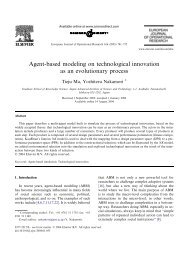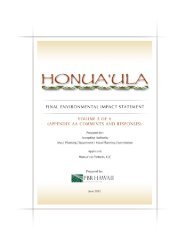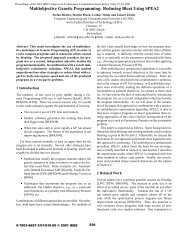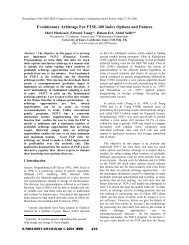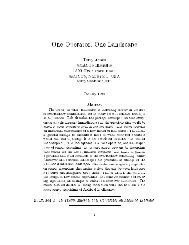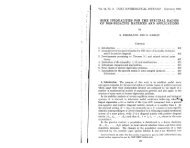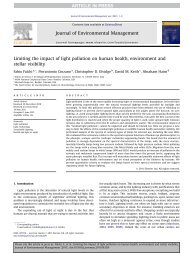In Memoriam Michael (Miki) Neumann (1946-2011)
In Memoriam Michael (Miki) Neumann (1946-2011)
In Memoriam Michael (Miki) Neumann (1946-2011)
Create successful ePaper yourself
Turn your PDF publications into a flip-book with our unique Google optimized e-Paper software.
<strong>In</strong> <strong>Memoriam</strong><br />
<strong>Michael</strong> (<strong>Miki</strong>) <strong>Neumann</strong> (<strong>1946</strong>-<strong>2011</strong>)<br />
by <strong>Michael</strong> Tsatsomeros 1<br />
With a quiet smile, a sense of self-effacement, some self-deprecation, and always with a grain of humor,<br />
<strong>Miki</strong> liked to claim that<br />
“... all I know is how to multiply matrices.”<br />
This statement epitomized <strong>Miki</strong>’s philosophy. You build knowledge methodically, upon fundamentals,<br />
with new ideas and careful reasoning. <strong>In</strong> all, you stay humble, measured, appreciative of your opportunities<br />
and confident of your accomplishments.<br />
<strong>Miki</strong> was a family man with paramount loyalty to his roots and faith. Married for nearly 38 years, <strong>Miki</strong><br />
and Helen raised two wonderful children, Joseph and Rachel. It only took a minute listening to <strong>Miki</strong> talk<br />
about them to understand how loving and proud he was of his children. At his induction as the Stuart and<br />
Joan Sidney Professor of Mathematics, <strong>Miki</strong> described how his father introduced him to calculus using the<br />
book Calculus Made Easy. When he became a father and was absorbed in his research projects, he recalled<br />
that his young daughter Rachel told friends, “My daddy is not a man, he’s a mathematician.”<br />
<strong>Michael</strong> <strong>Neumann</strong>’s Career<br />
<strong>Michael</strong> (<strong>Miki</strong>) <strong>Neumann</strong>, was born in Jerusalem in <strong>1946</strong>. He earned his B.Sc. from Tel Aviv University in<br />
1970 and his Ph.D. in Computer Science from London University in 1972. <strong>Miki</strong> taught at the University of<br />
Reading (72-73), the Technion-Israel <strong>In</strong>stitute of Technology in Haifa (73-75), the University of Nottingham<br />
(75-80), and the University of South Carolina (80-85). <strong>In</strong> 1985 he came to the University of Connecticut<br />
as Professor of Mathematics. <strong>Miki</strong> served as Head of the Department of Mathematics from 2003 until the<br />
time of his death. He was named a Board of Trustees Distinguished Professor in 2007, and appointed as<br />
1 Department of Mathematics, Washington State University, Pullman, WA 99164 (tsat@wsu.edu).<br />
1
the Stuart and Joan Sidney Professor of Mathematics in 2010. <strong>In</strong> 2007 <strong>Miki</strong> was elected to the Connecticut<br />
Academy of Arts and Sciences.<br />
<strong>Miki</strong>’s research received much recognition. His work is remarkable not only for its sheer quantity but<br />
even more so for its range and depth. As testament for his influence to Linear Algebra and the respect for<br />
his professional judgement, we need only note the numerous citations of his work, the consistent funding he<br />
received, as well as his service on the editorial boards of Linear Algebra and its Applications, the Electronic<br />
Journal of Linear Algebra, and Operators and Matrices.<br />
<strong>Miki</strong> was also a dedicated teacher. <strong>In</strong> the classroom, <strong>Miki</strong>’s priority was to communicate knowledge and<br />
to inspire his students to learn. He was the kind of teacher one appreciates more with time, because his<br />
teaching aspirations were more about substance and less about fanfare.<br />
As the years go by, his former graduate students become more and more convinced that <strong>Miki</strong> was a model<br />
adviser and mentor. By his example, he impressed in them the value of dedication to the profession, the<br />
value of academic integrity, and the importance of service. He taught his students masterfully the technical<br />
knowledge needed to start and sustain a research career, and also taught them the value of being patient<br />
and persevering in the quest for solutions.<br />
<strong>Miki</strong> remained very supportive of his students, colleagues and friends throughout their careers, and<br />
offered much needed help to many of us through personally trying times. He was genuinely interested in the<br />
well-being of his academic progeny beyond their professional lives.<br />
<strong>In</strong> his role as an administrator and in decision making positions, <strong>Miki</strong> prided himself, sometimes even<br />
obsessively, on being fair, respectful and appreciative of his colleagues and their efforts.<br />
To conclude, <strong>Miki</strong> will be remembered as the embodiment of a loving parent, a great mathematician and<br />
a superb human being. <strong>In</strong> the words of his colleague Stuart Sidney, we will miss the look of joyful expectation<br />
on his face, as if the next moment would hold a wonderful surprise.<br />
<strong>Michael</strong> <strong>Neumann</strong>’s Research<br />
<strong>Miki</strong> viewed his research as divided into five main and interconnected areas of Linear Algebra. They are<br />
described below, along with his contributions, largely in his own words.<br />
1. Iterative Methods for Linear Systems of Equations<br />
<strong>Miki</strong> made an important contribution to the subject by giving an exact characterization of four major<br />
subspaces that are important in determining, for a system of linear equations Ax = b and an iterative<br />
scheme xi = T xi−1 + c, the exact or approximate solution to which the iterates might converge (see [1, 3,<br />
4]). Two of the subspaces are the nullspace and range of A. The other two depend on the splitting of A into<br />
A = M − N and the iteration matrix T which they induce. Prior to the paper [3] by Berman and <strong>Neumann</strong>,<br />
knowledge of these subspaces was mostly confined to a narrow class of least-squares problems. <strong>Miki</strong>’s work<br />
on the convergence of iterative methods for singular systems led to his interest in the topic of nonnegative<br />
matrices because, in the presence of a nonnegative iteration matrix, much can be deduced about the necessary<br />
and the sufficient conditions for the convergence of an iteration scheme from both the numerical and the<br />
graph theoretical structure of the matrix (see [5, 7, 8, 15, 46]). <strong>Miki</strong>’s work on iterative methods deals also<br />
with conditions for convergence in the presence of iteration matrices which are not nonnegative, but have<br />
other recurring properties such as paracontracting, (see [43]), cyclicity (see [20, 38, 45, 53]), and positive<br />
definiteness (see [42]). Paracontracting matrices turned out to be particularly useful in parallel methods for<br />
solving systems of equations (see [43, 51, 57, 61, 62, 98]). <strong>Miki</strong> received research grants over a period of<br />
several years for his work on parallel methods.<br />
2. Nonnegative Matrix Theory<br />
At the time <strong>Miki</strong> became interested in the applications of nonnegative matrices to iterative methods<br />
2
for solving linear systems Ax = b, Richard Varga had produced a beautiful theory for the convergence of<br />
iterative methods induced by regular splittings when A is nonsingular. The transition to singular systems<br />
necessitated understanding the deeper relation of a nonnegative matrix to its Perron eigenspace. It is here<br />
that <strong>Miki</strong> made use of the existence of a nonnegative basis for the (generalized) Perron eigenspace of a<br />
nonnegative matrix. The proof of the existence of such a basis, due to Rothblum and Richman-Schneider,<br />
had a substantial combinatorial aspect to it. Yet, its use for investigating the convergence of iterative methods<br />
in [7] required no assumptions about the combinatorial structure of the splittings or the resulting iteration<br />
matrix. This made <strong>Miki</strong> and others wonder for many years whether there was a completely analytic proof of<br />
the existence of a nonnegative basis, until it was found in 1988 in joint work (see [52]) with Robert Hartwig<br />
and Nicholas Rose. The proof rested on the asymptotic expansion of the resolvent operator. <strong>Miki</strong> continued<br />
to work, mainly with Hans Schneider, on the relation between the analytic and combinatorial structure of<br />
nonnegative bases of nonnegative matrices and on how to generate them (see [60, 70]). Another aspect of<br />
<strong>Miki</strong>’s work on nonnegative matrices dealt with questions on convexity and concavity of the Perron root of<br />
a nonnegative matrix. Actually, these questions fall in the area of perturbation problems for nonnegative<br />
matrices (see [28, 35, 102, 116, 128, 144, 145, 146]). The main tools used here were generalized inverses of<br />
singular and irreducible M-matrices, on which <strong>Miki</strong> wrote over 20 papers (see e.g., [27, 28, 35, 74, 76, 78,<br />
83]). One of the papers, written jointly with Steve Kirkland, studies the form of the growth of the population<br />
in a Leslie population growth model (see [71]). Quite surprising conclusions concerning the effect on the rate<br />
growth of the population due to change in fecundity at different ages in the population are found there.<br />
Computational and perturbation questions for stochastic matrices have been considered in quite a few of<br />
<strong>Miki</strong>’s papers. For example, a well known idea of Carl Meyer is the decoupling of a Markov chain - or more<br />
practically its transition matrix - using Perron complementation. The task is to compute (possibly in parallel)<br />
by a divide and conquer method its stationary distribution vector. <strong>Miki</strong> and his co-authors showed that it is<br />
possible to extend this approach to the computation of the mean first passage times matrix (see [99, 111]).<br />
These papers demonstrate that using this approach is very economical in terms of the count of arithmetic<br />
operations. Other papers of <strong>Neumann</strong> on Markov chains are mostly concerned with estimating the error as a<br />
result of the computation (see [88, 124, 126, 141, 148]). Some of these papers are also concerned with special<br />
Markov processes that occur, for example, in small-world problems (see [134]). Perron complementation has<br />
appeared in many other papers by <strong>Miki</strong> and on a variety of topics. For example, on the inverse M-matrix<br />
problem (see [104], on totally nonnegative matrices (see [110]), on upper-estimates of permanents of doubly<br />
stochastic matrices (see [125]), and in the context of Soules bases (see [140]).<br />
The topic of Soules matrices mentioned above can be seen as part of <strong>Miki</strong>’s work on M-matrices and<br />
on the inverse M-matrix problem. <strong>Miki</strong>’s work on the inverse M-matrix problem starts with his joint paper<br />
with Lewin [13] in which the (0, 1)-matrices that are inverse M-matrices are characterized in a completely<br />
combinatorial way. This is among the first papers on the inverse M-matrix problem. Other papers on<br />
this topic are [55, 75, 82, 89, 96, 97, 104, 107, 138, 140, 143]. <strong>In</strong> this list, papers [89, 107, 138, 140, 143]<br />
concern the fascinating topic of the Soules matrices. Once it was realized that Soules matrices are inverse<br />
M-matrices and, up to positive diagonal scalings, ultrametric matrices, a connection to the research of many<br />
other matrix theorists became possible: on the topic of MMA-matrices (Friedland, Hershkowitz, Schneider,<br />
and Stuart), on ultrametric matrices (McDonald, Nabben, Schneider, Tsatsomeros, Varga), among others.<br />
Soules matrices and their eigenbases have also helped in the understanding of the inverse eigenvalue problem<br />
for nonnegative matrices (see [107, 138, 143]).<br />
The work on the Soules bases had recently become useful in a new area of interest for <strong>Miki</strong>, namely,<br />
recognizing objects and reconstructing images through nonnegative matrix factorizations (see [129]). Such<br />
factorizations are different from other methods of image reconstruction, because they make use of nonnegative<br />
constraints that allow additive approximations without cancellation. As a consequence, features of an image<br />
emerge with a sharper focus when reconstructed. An efficient algorithm for solving nonnegative matrix<br />
factorization problems is proposed in [152].<br />
3. Nonnegative Dynamic Systems<br />
3
<strong>In</strong> biological systems, such as models of predator-prey relationships, one can ask the following question:<br />
what is the set of all symbiosis points? These are initial states of evolving populations from which the populations<br />
are destined to become and remain non-decreasing. This concept, due to <strong>Neumann</strong> and Tsatsomeros<br />
([59]) is a special case of the so-called cone reachability problem. This problem entails finding the set of<br />
all points x0 ∈ R n such that the trajectory emanating from them enters the nonnegative orthant at some<br />
time t = t(x0) and remains in the orthant for all time thereafter. <strong>Miki</strong> and a colleague from Montreal, Ron<br />
Stern, investigated this problem and developed an approach to its solution based on an eigenspace deflation<br />
process (see [31, 33, 37], the latter paper also with A. Berman).<br />
Predator-prey problems can often be cast as systems of linear differential equations. Suppose now that<br />
we try to solve such a system of differential equations by means of a numerical approximation method, e.g.,<br />
Euler’s scheme. Then one question to be answered is this: If the continuous trajectory emanating from<br />
an initial state becomes and remains nonnegative, then does a discrete trajectory, (e.g., one generated by<br />
Euler’s scheme) also become and remain nonnegative? The answer to this question involves some delicate<br />
issues, particularly about points that reach and stay on the boundary of the nonnegative orthant. Using<br />
both asymptotic expansions and much eigenspace analysis, <strong>Miki</strong>, with Stern and Tsatsomeros, showed that<br />
under certain mild restrictions on the size of the time steps, the continuous and the discrete reachability<br />
cones coincide. This quite surprising, qualitative result was at the heart of the work of <strong>Miki</strong>’s second Ph.D.<br />
student, <strong>Michael</strong> Tsatsomeros. <strong>Miki</strong>, with Stern and Berman, published a book on reachability cones and<br />
related topics entitled Nonnegative Matrices in Dynamic Systems.<br />
4. Parallel Methods for Solving Linear Systems<br />
<strong>In</strong> the mid-80s, papers began to appear in which parallel computing methods (synchronous iteration) for<br />
solving large linear systems of equations were suggested. <strong>In</strong> some of these methods, the different operators<br />
to be successively applied were nonnegative matrices. At first, <strong>Miki</strong> tried to build a framework for analyzing<br />
parallel methods. <strong>Miki</strong> then went on to investigate chaotic, i.e., asynchronous iteration methods. The first<br />
task was to try and express the procedure in some mathematical fashion. Once this was done, then a concept<br />
mentioned earlier, that of paracontracting operators, helped in proving convergence results (see [43, 47, 51,<br />
57, 61, 62, 72]]). <strong>In</strong> one interesting paper (see [57]) it is proved that when increasing parallelization is<br />
applied to certain problems, then at first there is an improvement in the speed-up rate of the computation,<br />
but beyond a certain point the rate levels off because of communication overheads.<br />
5. The Algebraic Connectivity of Graphs<br />
There are types of matrices (e.g., adjacency matrices and Laplacian matrices) that can be used to model<br />
graphs. Certain parameters associated with these matrices can reveal properties of a graph, for example<br />
create a measure for the degree of its connectedness. One of these parameters is the second smallest eigenvalue<br />
of the Laplacian matrix, known as the algebraic connectivity of a graph. The computation of this eigenvalue<br />
can be expensive and therefore it becomes necessary to approximate it well. <strong>In</strong> the last several years,<br />
<strong>Miki</strong> had been particularly engaged in developing sensitive, yet economical, estimators for this quantity.<br />
Such estimates can be derived from the generalized inverse of the Laplacian matrix. At the heart of this<br />
approximation is the idea of the inverse eigenvalue iteration that can be extended to the nonzero spectrum<br />
of the Laplacian matrix. Much of this work is concerned with the equality case between the algebraic<br />
connectivity and its upper estimates, leading to interesting extremal graphs. <strong>Miki</strong> worked on problems<br />
associated with the algebraic connectivity of a graph with quite a few people: Barik, Kirkland, Molitierno,<br />
Pati, and Shader producing papers [80, 85, 86, 94, 103, 109, 112, 113, 119, 122, 123, 137, 142, 148].<br />
<strong>Michael</strong> <strong>Neumann</strong>’s Doctorate Students<br />
<strong>Miki</strong> advised nine Ph.D. students, listed below, all of whom went on to distinguished careers in Mathematics.<br />
What is more, they were all like family to <strong>Miki</strong> and Helen.<br />
Valerie Miller (1985); <strong>Michael</strong> J. Tsatsomeros (1990); Mei Gao (1993); Yonghong Chen (1994); Lixing Han<br />
4
(2000); Jason J. Molitierno (2001); Jianhong Xu (2003); Minerva Catral (2005); Upendra Prasad (2009).<br />
<strong>Michael</strong> <strong>Neumann</strong>’s Publications<br />
1. Subproper splitting for rectangular matrices, Linear Algebra Appl., 14:41-51, 1976.<br />
2. (with A. Berman) Proper splittings of rectangular matrices, SIAM J. Appl. Math., 31:307-312, 1976.<br />
3. (with A. Berman) Consistency and splittings, SIAM J. Numer. Anal., 13:877-888, 1976.<br />
4. (with S. P. Gudder) Splittings and iterative methods for approximate solutions to singular operator<br />
equations in Hilbert spaces, J. Math. Anal. Appl., 62:272-297, 1978.<br />
5. Some applications of partial orderings to iterative methods for rectangular linear systems, Linear<br />
Algebra Appl., 19:95-116, 1978.<br />
6. 3-part splittings for singular and rectangular linear systems, J. Math. Anal. Appl., 64:297-318, 1978.<br />
7. (with R. J. Plemmons) Convergent nonnegative matrices and iterative methods for consistent linear<br />
systems, Numer. Math., 31:265-279, 1978.<br />
8. (with R. J. Plemmons) Generalized inverse-positivity and splittings of M-matrices, Linear Algebra<br />
Appl., 23:21-36, 1979.<br />
9. Weak stability for matrices, Linear Multilinear Algebra, 7:257-263, 1979.<br />
10. A note on generalizations of strict diagonal dominance for real matrices, Linear Algebra Appl., 26:3-14,<br />
1979.<br />
11. (with D. W. Masser) On the square roots of quasi-accretive matrices, Linear Algebra Appl., 28:135-140,<br />
1979.<br />
12. (with C. R. Johnson) Square roots with positive definite hermitian part, Linear Multilinear Algebra,<br />
8:353-355, 1980.<br />
13. (with M. Lewin) The inverse M-matrix problem for (0,1)-matrices, Linear Algebra Appl., 30:41-50,<br />
1980.<br />
14. (with R. J. Plemmons) M-matrix characterizations II: General M-matrices, Linear Multilinear Algebra,<br />
9:211-225, 1980.<br />
15. (with R. S. Varga) On the sharpness of some upper bounds for the spectral radii of S.O.R. iteration<br />
matrices, Numer. Math., 35:69-79, 1980.<br />
16. A combined direct-iterative approach for solving large scale singular and rectangular consistent systems<br />
of linear equations, Linear Algebra Appl., 34:85-101, 1980.<br />
17. (with J. de Pillis) A noncommutative spectral theorem for operator entried companion matrices, Linear<br />
Multilinear Algebra, 10:45-51, 1981.<br />
18. On the Schur complement and the LU-factorization of a matrix, Linear Multilinear Algebra, 9:241-254,<br />
1981.<br />
19. (with J. de Pillis) Iterative methods with k-part splittings, IMA J. Numer. Anal., 1:65-79, 1981.<br />
20. The Kahan S.O.R. convergence bound for nonsingular and irreducible M-matrices, Linear Algebra<br />
Appl., 39:205-222, 1981.<br />
5
21. (with L. Elsner and C. R. Johnson) The effect of the perturbation of a nonnegative matrix on its Perron<br />
eigenvector, Czechoslovak Math. J., 32:99-109, 1982.<br />
22. (with J. Buoni and R. S. Varga) Theorems of Stein-Rosenberg type III: The singular case, Linear<br />
Algebra Appl., 42:183-198, 1982.<br />
23. (with G. Poole and H. Werner) More on the generalizations of matrix monotonicity, Linear Algebra<br />
Appl., 48:413-435, 1982.<br />
24. (with R. E. Funderlic and R. J. Plemmons) LU decompositions of generalized diagonally dominant<br />
matrices, Numer. Math., 40:57-69, 1982.<br />
25. (with M. Fiedler and T. L. Markham) Classes of products of M-matrices and inverse M-matrices,<br />
Linear Algebra Appl., 52/53:265-287, 1983.<br />
26. On bounds for the convergence of the SSOR method for H-matrices, Linear Multilinear Algebra, 15:13-<br />
21, 1984.<br />
27. (with S. R. Mohan and K. G. Ramamurthy) Nonnegativity of principal minors of generalized inverses<br />
of M-matrices, Linear Algebra Appl., 58:247-259, 1984.<br />
28. (with E. Deutsch) Derivatives of the Perron root at an essentially nonnegative matrix and the group<br />
inverse of an M-matrix, J. Math. Anal. Appl., 102:1-29, 1984.<br />
29. (with R. J. Plemmons) Backward error analysis for linear systems associated with inverses of Hmatrices,<br />
BIT, 24:102-112, 1984.<br />
30. (with J. de Pillis) The effect of the perturbation of hermitian matrices on their eigenvectors, SIAM J.<br />
Alg. Discrete Methods (SIMAX), 6:201-209, 1985.<br />
31. (with R. J. Stern) Boundary results for positively invariant cones and their reachability cones, Linear<br />
Multilinear Algebra, 17:143-154, 1985.<br />
32. (with T. L. Markham and R. J. Plemmons) Convergence of a direct-iterative method for large-scale<br />
least squares problems, Linear Algebra Appl., 69:155-167, 1985.<br />
33. (with R. J. Stern) Cone reachability for linear differential systems, Appl. Anal., 20:57-71, 1985.<br />
34. (with M. Fiedler, C. R. Johnson, and T. L. Markham) A trace inequality for M-matrices and symmetrizability<br />
of a real matrix by a positive diagonal matrix, Linear Algebra Appl., 71:81-94, 1985.<br />
35. (with E. Deutsch) On the first and second derivatives of the Perron vector, Linear Algebra Appl.,<br />
71:57-76, 1985.<br />
36. (with V. Miller) A note on comparison theorems for nonnegative iteration matrices, Numer. Math.,<br />
47:427-434, 1985.<br />
37. (with A. Berman and R. J. Stern) Cone reachability for nondiagonable linear differential systems,<br />
Linear Algebra Appl., 81:263-280, 1986.<br />
38. Neighborhoods of dominant convergence for the SSOR method, SIAM J. Alg. Discrete Methods<br />
(SIMAX), 7:551-559, 1987.<br />
39. (with V. Miller) Successive overrelaxation methods for solving the rank deficient linear least squares<br />
problem, Linear Algebra Appl., 88/89:533-557, 1987.<br />
40. (with R. J. Plemmons) Convergence of parallel multisplitting iterative methods for M-matrices, Linear<br />
Algebra Appl., 88/89:559-573, 1987.<br />
6
41. (with E. Deutsch) On the derivative of the Perron vector whose infinity norm is fixed, Linear Multilinear<br />
Algebra, 21:75-85, 1987.<br />
42. (with S. Nelson) Generalizations of the projection method with applications to SOR theory for hermitian<br />
positive semidefinite systems, Numer. Math., 51:123-141, 1987.<br />
43. (with R. Bru and L. Elsner) Models of parallel chaotic iteration methods, Linear Algebra Appl., 103:175-<br />
192, 1988.<br />
44. (with R. Bru) Nonnegative Jordan Basis, Linear Multilinear Algebra, 23:95-109, 1988.<br />
45. (with A. Hadjidimos) A note on the SSOR convergence domain due to Neumaier and Varga, Linear<br />
Algebra Appl., 107: pp.207-217, 1988.<br />
46. (with G. Avdelas, J. de Pillis, and A. Hadjidimos) A guide to the acceleration of iterative methods<br />
whose iteration matrix is nonnegative and convergent, SIAM J. Matrix Anal. Appl., 9:329-342, 1988.<br />
47. (with P. J. Kavanagh) Consistency and convergence of the parallel multisplitting method for singular<br />
M-matrices, SIAM J. Matrix Anal. Appl., 10:210-218, 1989.<br />
48. (with R. J. Stern) Discrete approximations to reachability cones of linear differential equations, Linear<br />
Algebra Appl., 120:65-79, 1989.<br />
49. (with A. Hadjidimos) Precise domains of convergence for the block SSOR method associated with<br />
p-cyclic matrices, BIT, 29:311-320, 1989.<br />
50. (with M. Hanke) Preconditioning and splittings for rectangular systems, Numer. Math., 57:85-95,<br />
1990.<br />
51. (with L. Elsner and I. Koltracht) On the convergence of asynchronous paracontractions with application<br />
to tomographic reconstruction from incomplete data, Linear Algebra Appl., 130:65-82, 1990.<br />
52. (with R. E. Hartwig and N. J. Rose) An algebraic-analytic approach to nonnegative basis, Linear<br />
Algebra Appl., 133:77-88, 1990.<br />
53. (with A. Hadjidimos) Convergence domains of the SSOR method for generalized consistently ordered<br />
matrices, J. Comput. Appl. Math., 33:35-52, 1990.<br />
54. (with R. J. Stern and M. Tsatsomeros) The reachability cones of essentially nonnegative matrices,<br />
Linear Multilinear Algebra, 28:213-224, 1991.<br />
55. (with I. Koltracht) On the inverse M-matrix problem for real symmetric positive definite Toeplitz<br />
matrices, SIAM J. Matrix Anal. Appl., 12:310-320, 1991.<br />
56. (with H. J. Werner) Nonnegative group inverses, Linear Algebra Appl., 151:85-96, 1991.<br />
57. (with E. Elsner and B. Vemmer) The effect of the number of processors on the convergence of the<br />
parallel block Jacobi method, Linear Algebra Appl., 154-156:311-330, 1991.<br />
58. (with M. Hanke and W. Niethammer) On the SOR method for symmetric positive definite systems,<br />
Linear Algebra Appl., 154/156:457-472, 1991.<br />
59. (with M. Tsatsomeros) Symbiosis points for linear differential systems, Linear Multilinear Algebra,<br />
30:49-59, 1991.<br />
60. (with H. Schneider) Principal components of minus M-matrices, Linear Multilinear Algebra, 32:131-148,<br />
1992.<br />
61. (with L. Elsner and I. Koltracht) Convergence of sequential and asynchronous nonlinear paracontractions,<br />
Numer. Math., 62:305-319, 1992.<br />
7
62. (with L. Elsner) Monotonic sequences and rates of convergence of asynchronized iterative methods,<br />
Linear Algebra Appl., 180:17-33, 1993.<br />
63. (with R. E. Hartwig) Bounds on the exponent of primitivity which depend on the spectrum and the<br />
minimal polynomial, Linear Algebra Appl., 184:103-122, 1993.<br />
64. (with L. Elsner, I. Koltracht, and D. Xiao) On accurate computations of the root, SIAM J. Matrix<br />
Anal. Appl., 14:457-467, 1993.<br />
65. (with A. Hadjidimos) On domains of superior convergence of the SSOR method over the SOR method,<br />
Linear Algebra Appl., 187:67-85, 1993.<br />
66. (with M. Gao) A global minimum search algorithm for estimating the distance to uncontrollability,<br />
Linear Algebra Appl., 189:305-350, 1993.<br />
67. (with M. Hanke) The geometry of the set of scaled projections, Linear Algebra Appl., 190:137-148,<br />
1993.<br />
68. (with I. Koltracht and D. Xiao) On a question of Boyle and Handelman concerning eigenvalues of<br />
nonnegative matrices, Linear Multilinear Algebra, 36:125-140, 1993.<br />
69. (with J. J. McDonald and H. Schneider) Resolvents of minus M-matrices and splittings of M-matrices,<br />
Linear Algebra Appl., 195:17-33, 1993.<br />
70. (with H. Schneider) Algorithms for computing bases for the Perron eigenspace with prescribed nonnegativity<br />
and combinatorial properties, SIAM J. Matrix Anal. Appl., 15:578-591, 1994.<br />
71. (with S. J. Kirkland) Convexity and concavity of the Perron root and vector of Leslie matrices with<br />
applications to a population model, SIAM J. Matrix Anal. Appl., 15:1092-1107, 1994.<br />
72. (with R. Bru and L. Elsner) Convergence of infinite products of matrices and inner-outer iterations<br />
schemes, Electron. Trans. Numer. Anal., 2:183-193, 1994.<br />
73. (with R. Bru and J. J. Climent) On the index of block upper triangular matrices, SIAM J. Matrix<br />
Anal. Appl., 16:436-447, 1995<br />
74. (with S. J. Kirkland) Group inverses of M-matrices associated with nonnegative matrices having few<br />
eigenvalues, Linear Algebra Appl., 220:181-213, 1995.<br />
75. (with J. J. McDonald, H. Schneider, and M. J. Tsatsomeros) <strong>In</strong>verse M-matrix inequalities and generalized<br />
ultrametric matrices, Linear Algebra Appl., 220:321-341, 1995.<br />
76. (with Y. Chen and S. J. Kirkland) Group generalized inverses of M-matrices associated with periodic<br />
and nonperiodic Jacobi matrices, Linear Multilinear Algebra, 39:325-340, 1995.<br />
77. (with A. Hadjidimos) Superior convergence domains for the p-cyclic SSOR majorizer, J. Comput. Appl.<br />
Math., 62:27-40, 1995.<br />
78. (with Y. Chen and S. J. Kirkland) Nonnegative alternating circulants leading to M-matrix group<br />
inverses, Linear Algebra Appl., 233:81-97, 1996.<br />
79. (with C. R. Johnson and M. J. Tsatsomeros) Conditions for the positivity of determinants, Linear<br />
Multilinear Algebra, 40:241-248, 1996.<br />
80. (with S. J. Kirkland and B. L. Shader), Characteristic vertices of weighted trees via Perron values,<br />
Linear Multilinear Algebra, 40:311-325, 1996.<br />
81. (with D. Hershkowitz, W. Huang, and H. Schneider), Minimization of norms and the spectral radius<br />
of a sum of nonnegative matrices under diagonal equivalence), Linear Algebra Appl., 241/243:431-453,<br />
1996.<br />
8
82. (with J. J. McDonald, H. Schneider, and M. Tsatsomeros) <strong>In</strong>verses of unipathic M-matrices, SIAM J.<br />
Matrix Anal. Appl., 17:1025-1036, 1996.<br />
83. (with Y. Chen) M-matrix generalized inverses of M-matrices, Linear Algebra Appl., 256:263-285, 1997.<br />
84. (with R. A. Gonzales, J. Eisert, I. Koltracht, and G. Rawitscher) <strong>In</strong>tegral equations methods for the<br />
continuous spectrum radial Schroedinger equation, J. Comput. Phys., 134:134-149, 1997.<br />
85. (with S. J. Kirkland and B. L. Shader) Distances in weighted trees and group inverses of Laplacian<br />
matrices, SIAM J. Matrix Anal. Appl., 18:827-841, 1997.<br />
86. (with S. J. Kirkland) Algebraic connectivity of weighted trees under perturbation,Linear Multilinear<br />
Algebra, 42:187-203, 1997.<br />
87. (with J. Climent and A. Sidi) A semi-iterative method for real spectrum singular linear systems with<br />
an arbitrary index, J. Comput. Appl. Math., 87:21-38, 1997.<br />
88. (with S. J. Kirkland and B. L. Shader) Applications of Paz’s inequality to perturbation bounds for<br />
Markov chains, Linear Algebra Appl., 268:183-196, 1998.<br />
89. (with L. Elsner and R. Nabben) Orthogonal bases which lead to symmetric nonnegative bases, Linear<br />
Algebra Appl., 271:323-343, 1998.<br />
90. (with A. Hadjidimos) On the minimization of the 2-norms of the SOR and MSOR operators, SIAM J.<br />
Matrix Anal. Appl., 19:191-204, 1998.<br />
91. (with S. J. Kirkland) The M-matrix group generalized inverse problem for weighted trees, SIAM J.<br />
Matrix Anal. Appl., 19: 226-234, 1998.<br />
92. (with M. T. Chien) Positive definiteness of tridiagonal matrices via the numerical range, Electron. J.<br />
Linear Algebra, 3:93-102, 1998.<br />
93. (with S. J. Kirkland and B. L. Shader) Bounds on the subdominant eigenvalue involving group inverses<br />
with applications to graphs, Czechoslovak Math. J., 48:1-20, 1998.<br />
94. (with S. J. Kirkland and B. L. Shader), On a bound on algebraic connectivity: The case of equality,<br />
Czechoslovak Math. J., 48:65-76, 1998.<br />
95. (with L. Elsner, L. Han, and M. Zippin) On a polygon equality problem, J. Math. Anal. Appl.,<br />
224:67-75, 1998.<br />
96. A conjecture concerning the Hadamard product of inverses of M-matrices, Linear Algebra Appl.,<br />
285:277-290, 1998.<br />
97. (with J. J. McDonald, R. Nabben, H. Schneider, and M. J. Tsatsomeros) <strong>In</strong>verse tridiagonal Z-matrices,<br />
Linear Multilinear Algebra, 45:75-97, 1998.<br />
98. (with H. Schneider) Partial norms and the convergence of general products of matrices, Linear Algebra<br />
Appl., 287:307-314, 1999.<br />
99. (with S. J. Kirkland) Cutpoint decoupling and first passage times for random walks on graphs, SIAM<br />
J. Matrix Anal. Appl., 20:860-870, 1999.<br />
100. (with D. Hershkowitz and H. Schneider) Hermitian positive semidefinite matrices whose entries are 0<br />
or 1 in modulus, Linear Multilinear Algebra, 46:259-264, 1999.<br />
101. (with S. J. Kirkland) On group inverses of M-matrices with uniform diagonal entries, Linear Algebra<br />
Appl., 296:153-170, 1999.<br />
9
102. (with L. Han and M. J. Tsatsomeros) Spectral radii of fixed Frobenius norm perturbations of nonnegative<br />
matrices, SIAM J. Matrix Anal. Appl., 21:79-92, 1999.<br />
103. (with J. J. Molitierno and B. Shader) Tight bounds on the algebraic connectivity of a balanced binary<br />
tree, Electron. J. Linear Algebra, 6:62-71, 2000.<br />
104. <strong>In</strong>verses of Perron complements of inverse M-matrices, Linear Algebra Appl., 313:163-171, 2000.<br />
105. (with S. J. Kirkland) Regular Markov chains for which the transition matrix has large exponent, Linear<br />
Algebra Appl., 316:45-65, 2000.<br />
106. (with G. Goldberg, P. Okunev, and H. Schneider) Distribution of subdominant eigenvalues of random<br />
matrices, Methodol. Comput. Appl. Probab., 2:137-151, 2000.<br />
107. (with J. J. McDonald) The Soules approach to the inverse eigenvalue problem for nonnegative symmetric<br />
matrices of order n ≤ 5, Contemp. Math., 259:387-407, 2000.<br />
108. (with S. J. Kirkland) Extremal first passage times for trees, Linear Multilinear Algebra, 48:21-33, 2000.<br />
109. (with J. J. Molitierno) The algebraic connectivity of two trees connected by an edge of infinite weight,<br />
Electron. J. Linear Algebra, 8:1-13, 2001.<br />
110. (with S. Fallat) On Perron complements of totally nonnegative matrices, Linear Algebra Appl., 327:85-<br />
94, 2001.<br />
111. (with S. J. Kirkland and J. Xu) A divide and conquer approach to computing the mean first passage<br />
matrix for Markov chains via Perron complement reductions, Numer. Linear Algebra Appl., 8:287-295,<br />
2001.<br />
112. (with S. J. Kirkland and J. J. Molitierno) The sharpness of a lower bound on the algebraic connectivity<br />
for maximal graphs, Linear Multilinear Algebra, 48:237-246, 2001.<br />
113. (with S. J. Kirkland, J. J. Molitierno, and B. L. Shader) On graphs with equal algebraic and vertex<br />
connectivity, Linear Algebra Appl., 341:45-56, 2002.<br />
114. (with A. Goldberger) The Hadamard product of circulant matrices on three symbols which are inverses<br />
of M-matrices, Linear Multilinear Algebra, 50:143-149, 2002.<br />
115. (with A. Goldberger) On a strong form of a conjecture of Boyle and Handelman, Electron. J. Linear<br />
Algebra, 9:138-149, 2002.<br />
116. (with S. J. Kirkland, N. Ormes, and J. Xu) On the elasticity of the Perron root of a nonnegative<br />
matrix, SIAM J. Matrix Anal. Appl., 24:454-464, 2002.<br />
117. (with G. Goldberg) Distribution of subdominant eigenvalues of matrices with random rows, SIAM J.<br />
Matrix Anal. Appl., 24:747-761, 2003.<br />
118. (with L. Han and J. Xu) On the roots of certain polynomials arising from the analysis of the Nelder-<br />
Mead simplex method, Linear Algebra Appl., 363:109-124, 2003.<br />
119. (with J. J. Molitierno) On trees with perfect matchings, Linear Algebra Appl., 362:75-85, 2003.<br />
120. (with N. Ormes) Bounds for graph expansions via elasticity, Electron. J. Linear Algebra, 10:163-178,<br />
2003.<br />
121. (with A. Goldberger) Multilinear functional inequalities involving permanents, determinants, Linear<br />
Algebra Appl., 369:295-310, 2003.<br />
122. (with S. J. Kirkland) On algebraic connectivity as a function of an edge weight, Linear Multilinear<br />
Algebra, 52:17-33, 2004.<br />
10
123. (with J. J. Molitierno) On operations in which graphs are appended to trees, Linear Multilinear Algebra,<br />
52:145-156, 2004.<br />
124. (with J. Xu) On the stability of the computation of the stationary distribution probabilities of Markov<br />
chains using Perron complements, Numer. Linear Algebra Appl., 10:603-618, 2003.<br />
125. (with R. Bapat) <strong>In</strong>equalities for permanents involving Perron complements, Linear Algebra Appl.,<br />
385:95-104, 2004.<br />
126. (with J. Xu) Improved bounds for a condition number for Markov chains, Linear Algebra Appl., 386:225-<br />
241 2004.<br />
127. (with A. Goldberger) An improvement of an inequality of Fiedler leading to a new conjecture on<br />
nonnegative matrices, Czechoslovak Math. J., 54:773-780, 2004.<br />
128. (with S. J. Kirkland and J. Xu) Convexity and elasticity of the growth rate in stage-based population<br />
models, SIAM J. Matrix Anal. Appl., 26:170-185, 2004.<br />
129. (with M. Catral, L. Han, and R. J. Plemmons) On reduced rank nonnegative matrix factorization for<br />
symmetric nonnegative matrices, Linear Algebra Appl., 393:107-126, 2004.<br />
130. (with A. Goldberger) Perron-Frobenius theory: a topological approach, Linear Algebra Appl., 399:245-<br />
284, 2005.<br />
131. (with J. Xu) A parallel algorithm for computing the group inverse via Perron complementation, Electron.<br />
J. Linear Algebra, 13:131-145, 2005.<br />
132. (with R. Bapat and S. J. Kirkland) On distance matrices and Laplacians, Linear Algebra Appl., 401:193-<br />
209, 2005.<br />
133. (with M. Catral and J. Xu) Proximity in group inverses of M-matrices and inverses of diagonally<br />
dominant M-matrices, Linear Algebra Appl., 409:32-50, 2005.<br />
134. (with M. Catral and J. Xu) Matrix analysis of a Markov chain small-world model, Linear Algebra<br />
Appl., 409:126-146, 2005.<br />
135. (with R. Bapat and M. Catral) On functions that preserve M-matrices and inverse M-matrices, Linear<br />
Multilinear Algebra, 53:193-201, 2005.<br />
136. (with L. Han) Effect of Dimensionality on the Nelder-Mead Simplex Method, Optim. Methods Softw.,<br />
21:1-16, 2006.<br />
137. (with S. Fallat, S. J. Kirkland, and J. J. Molitierno) On graphs whose Laplacian matrices have distinct<br />
integer eigenvalues, J. Graph Theory, 50:162-174, 2005.<br />
138. (with M. Chen and L. Han) On single and double Soules matrices, Linear Algebra Appl., 416:88-110,<br />
2006.<br />
139. (with J. Xu) On Newton and Newton-like inequalities for M- matrices and for Drazin inverses of<br />
M-Matrices, Electron. J. Linear Algebra, 15:314-328, 2006.<br />
140. (with M. Chen and N. Shaked-Monderer) Double Soules pairs and matching Soules bases, Linear<br />
Algebra Appl., 421:315-327, 2007.<br />
141. (with S. J. Kirkland and J. Xu) Transition matrices for well-conditioned Markov chains, Linear Algebra<br />
Appl., 424:118-131, 2007.<br />
142. (with S. Barik and S. Pati) On nonsingular trees and a reciprocal eigenvalue property, Linear Multilinear<br />
Algebra, 54:453-465, 2006.<br />
11
143. (with N. Sze) Optimization of the spectral radius of nonnegative matrices, Oper. Matrices, 1:593-601,<br />
2007.<br />
144. (with N. Sze) A note on the perturbation of positive matrices by normal and unitary matrices, Linear<br />
Algebra Appl., 428:224-229, 2008.<br />
145. (with M. Chen and N. Shaked-Monderer) Basic Soules matrices and their applications, Linear Algebra<br />
Appl., 429:951-971, 2008.<br />
146. (with S. J. Kirkland and N. Sze) On optimal condition for Markov chains, Numer. Math., 110:521-537,<br />
2008.<br />
147. (with J. Axtell, L. Han, D. Hershkowitz, and N. Sze) Optimization of the spectral radius of a product<br />
for nonnegative matrices, Linear Algebra Appl., 430:1442-1451, 2009.<br />
148. (with S. Pati) The Laplacian spectra of graphs with a tree structure, Linear Multilinear Algebra,<br />
57:267-291, 2009.<br />
149. (with J. Han, L. Han, U. Prasad) On the rate of convergence of the image space reconstruction<br />
algorithm, Oper. Matrices, 3:41-58, 2009.<br />
150. (with A. Goldberger) An upper bound on the characteristic polynomial of a nonnegative matrix leading<br />
to a proof of the Boyle-Handelman conjecture, Proc. Amer. Math. Soc., 137:1529-1538, 2009.<br />
151. (with S. J. Kirkland) The case of equality in the Dobrushin-Deutsch-Zenger bound, Linear Algebra<br />
Appl., 431:2372-2394, 2009.<br />
152. (with L. Han and U. Prasad) Alternating projected Barzilai-Borwein methods for nonnegative matrix<br />
factorization, Electron. Trans. Numer. Anal., 36:54-82, 2009/10.<br />
153. (with M. Catral, S. J. Kirkland, and N. Sze), The Kemeny constant for finite homogeneous ergodic<br />
Markov chains, J. Sci. Comput., 45:151-166, 2010.<br />
154. (with N. Sze) On the inverse mean first passage matrix problem and the inverse M-matrix problem,<br />
Linear Algebra Appl., 434:1620-1630, <strong>2011</strong>.<br />
<strong>Michael</strong> <strong>Neumann</strong> co-authored with Abraham Berman and Ronald J. Stern the research monograph<br />
Nonnegative Matrices in Dynamic Systems, Series in Pure and Applied Mathematics, Wiley <strong>In</strong>terscience,<br />
New York, 1989.<br />
Acknowledgements. I would like to thank all colleagues and friends who contributed to this article.<br />
<strong>In</strong> particular, I thank Helen <strong>Neumann</strong> and <strong>Miki</strong>’s colleagues at UConn, Bill Abikoff, Stuart Sidney, Ron<br />
Blei and Vadim Olshevsky. Also I appreciate comments provided by Hans Schneider, Steve Kirkland, Jason<br />
Molitierno, Minnie Catral, and Lixing Han. The photograph was taken by Maxine Lerman on March 30,<br />
<strong>2011</strong>. It proved to be the last photo taken of <strong>Miki</strong>.<br />
12



